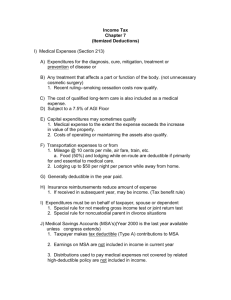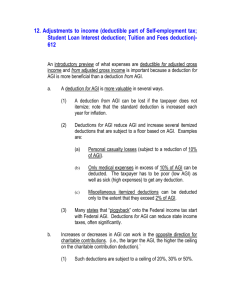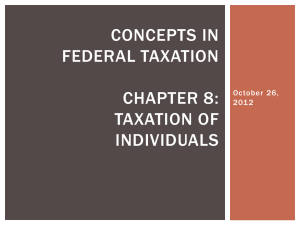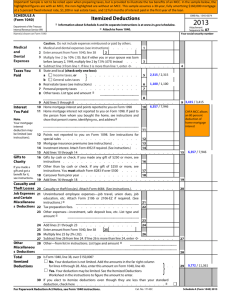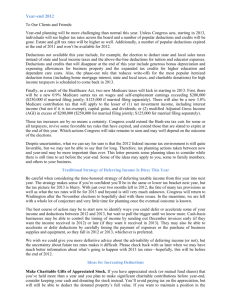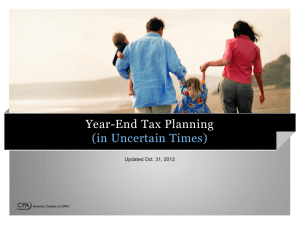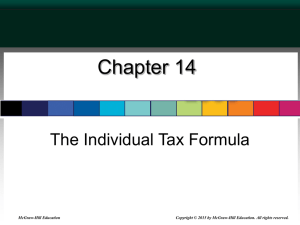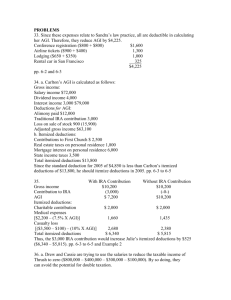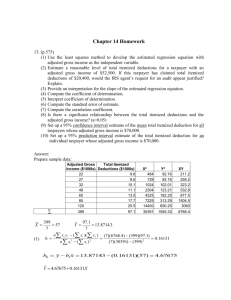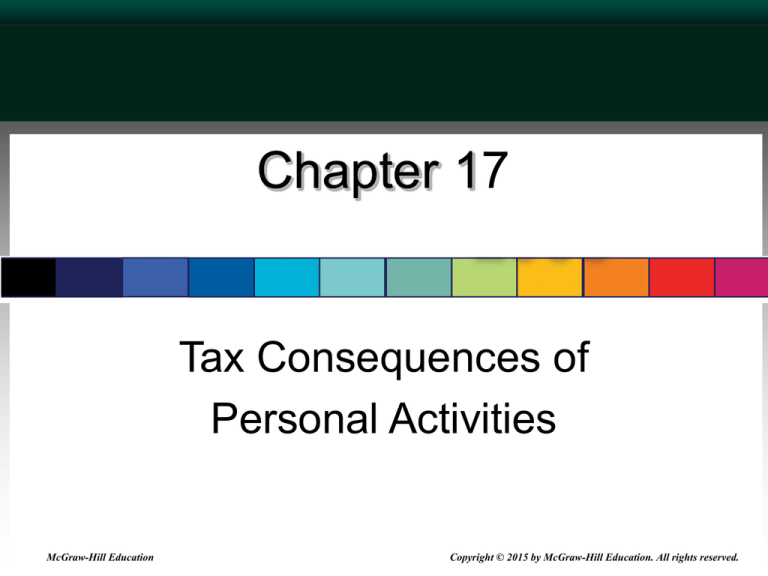
Chapter 17
Tax Consequences of
Personal Activities
McGraw-Hill Education
McGraw-Hill/Irwin
Copyright © 2015 by McGraw-Hill Education. All rights reserved.
© 2007 The McGraw-Hill Companies, Inc., All Rights Reserved.
17-2
Objectives
• Identify personal receipts that are taxable income
• Describe the tax consequences of divorce settlements
• Identify personal expenses and losses that result in itemized
deductions
• Describe the tax treatment of revenues and expenses from a
hobby
• Compute the itemized deduction for home mortgage interest
• Describe the preferential treatment of gain from the sale of a
personal residence
• Identify itemized deductions that are limited or disallowed for
AMT purposes
17-3
Gross Income
• Section 61 states that gross income means all
income from whatever source derived – even
income from personal activities
17-4
Gratuitous Receipts
• Prizes and awards are included in
gross income
• Scholarships are excluded to
extent spent on:
• Tuition, books, fees, equipment
required by institution
• Gifts, inheritances, and life
insurance death benefits are
excluded from gross income
17-5
Legal Settlements and Government Payments
• Legal settlements are included in gross income unless
compensation for physical injury or illness
• Workers’ compensation is excluded
• Unemployment compensation is included
• Need-based payments such as welfare
and food stamps are excluded
• Social Security:
• 85%, 50%, or 0% included in gross income depending
on income level
17-6
Application Problem 1
• Marcy Tucker received the following items.
Determine to what extent each item is included
in gross income.
• $25,000 cash gift from her parents
• $500 cash award from the local Chamber of Commerce
for her winning entry in a contest to name a new public
park
• $8,000 alimony from her former husband
• $100,000 cash inheritance from her grandfather
17-7
Divorce
• Property settlements are
nontaxable
• Transferred property
takes a carryover basis
• Alimony is taxable to the recipient, deductible
above-the line by the payer
• Child support is neither taxable nor deductible
17-8
Divorce Example
• Ted and Alice divorced on July 1. In the property
settlement, Ted transferred one-half ownership of their
home (FMV $250,000) to Alice. Ted will pay $450 per
month alimony and $800 per month child support
• Tax consequences to Ted?
• No deduction for property transfer or payment of child support.
Ted has a $2,700 ($450 x 6 months) above-the-line deduction for
payment of alimony
• Tax consequences to Alice?
• No income from the receipt of property or child support. Alice
recognizes $2,700 ordinary income from receipt of alimony
17-9
Personal Use Assets and
Personal Expenses
• Personal use assets
• Personal use assets may not be depreciated
• Gains on sale are capital gain
• Losses on sale are not deductible
• No deduction is allowed for personal, living, or
family expenses except for:
•
•
•
•
Medical expenses
Certain taxes
Home mortgage interest
Charitable contributions
17-10
Personal Expenses - Medical
• Taxpayers may deduct the excess of unreimbursed
expenses over 10% of AGI as an itemized
deduction
• 10% decreased to 7.5% for taxpayer age 65 or older
• Qualifying medical expenses include:
•
•
•
•
•
Clinics, hospitals, long-term care facilities
Medical aids (e.g., hearing aids, crutches)
Prescription drugs
Medical insurance premiums
Doctors, dentists, chiropractors
17-11
Medical Expenses Example
• Sam, age 42, incurred the following unreimbursed expenses
•
•
•
•
•
•
Health insurance premiums
Prescription drugs
Hospital bills
Doctor bills
Wheelchair
Diet food and pills, non Rx
$2,200
600
2,000
900
100
250
• If Sam’s AGI is $55,000, compute his medical expense
deduction
• $5,800 – ($55,000 x 10%) = $300
17-12
Personal Expenses - Taxes
• Individuals are allowed an itemized deduction for:
• Real or personal property taxes paid on nonbusiness
assets
• Either state and local sales taxes or state and local
income taxes
• Costs of tax compliance (e.g. tax preparation fees)
are miscellaneous itemized deductions
17-13
Personal Expenses – Charitable Contributions
• General limit – Itemized deduction limited to 50% of
AGI for cash donation (less for capital assets)
• Carryover excess as an itemized deduction for 5 years
• Deduction amount
• LT capital assets = FMV of property
• Other property = lesser of FMV or basis
17-14
Charitable Contribution Example
• Mrs. Bain gave the following to charity this year
• Antiques (owned 15 years; cost $50,000; FMV $125,000)
• Painting (owned 9 months; cost $25,000; FMV $27,000)
• Compute Mrs. Bain’s itemized deduction for
charitable contributions before AGI limitation
• $125,000 (FMV of antiques) + $25,000 (basis of painting)
= $150,000 deduction
17-15
Tax Subsidies for Education
• EE Savings Bonds
• Deduction for qualified tuition and fees
• Deduction for interest on qualified education loans
• American Opportunity Credit
• Lifetime Learning Credit
• Qualified tuition programs
• Coverdell education savings accounts
17-16
Casualty Losses
• Casualty and theft losses
• Loss equals lesser of adjusted basis or
decline in FMV of property resulting
from casualty or theft
• Loss reduced by insurance
reimbursement
• Loss in excess of $100 floor per
casualty is deductible
• Deduction limited to excess of
aggregate losses over 10% AGI
17-17
Hobby and Gambling Losses
• Activity not entered into for profit (hobby)
• Revenue included in gross income
• Expenses are miscellaneous itemized deductions
limited to revenue from hobby
• If the activity generates a profit in 3 of 5 years, IRS
presumes it is a business and losses are deductible
• Gambling losses
• Itemized deduction but not miscellaneous
• Limited to gambling winnings
17-18
Home Mortgage Interest
• Qualified residence interest is itemized deduction
• Interest on acquisition debt up to $1 million
• Interest on home equity debt up to $100,000
• Deduction for mortgage on principal residence and
one other personal residence
17-19
Vacation Home Rental
• Residence is subject to vacation home rules if
owner’s days of personal use exceed greater of 14
days or 10% of rental days
• Expenses attributable to rental days are deductible
to extent of rental revenues
• Vacation home rental can’t generate a net loss deductible
against other income
• Nondeductible loss carries forward
17-20
Gain on Sale of Principal Residence
• $250,000 exclusion of gain on sale of home
• Owner must have used the home as a principal residence
for two years out of five years ending on date of sale
• Exclusion doubled to $500,000 for MFJ
• Exclusion applies to only one sale in a two-year period
• Owners who sell a home but don’t satisfy above
requirements may be eligible for reduced exclusion
if sale was necessitated by:
• Change of employment
• Health reasons
• Unforeseen circumstances
17-21
Itemized Deductions as AMT Adjustments
• Medical deductions are allowed only to the extent
they exceed 10% AGI
• Deductions for state and local taxes are disallowed
• Miscellaneous itemized deductions are disallowed
• Interest on home equity debt is disallowed
17-22

